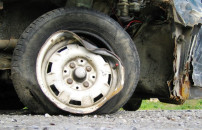Six dolphins found dead in last six days in Sukkur
Laboratory report found no traces of chemicals in water, cause of deaths remains unknown.

Around 12 days ago, a large number of dead fish had washed up on the river banks in Soomar Panhwari and Khaderi areas of Pannu Aqil. Some of the residents had alleged that people had been using poisonous chemicals to kill the fish and secure a larger catch to sell in the markets. Samples of the water were sent to the laboratory to find out what chemicals were used.
In the meanwhile, at least six more Indus blind dolphins have been found dead in the river between Guddu and Sukkur barrages and the Sindh wildlife department is blaming fishermen for these deaths. The department alleged that fishermen are using poisonous chemicals to kill fish, which is contaminating the river water while the fishermen said that the contamination is through no fault of theirs. While some of the fishermen had admitted they used chemicals to catch fish, they had said they used very little amounts, which only forces the fish to come to the surface. The effect of the chemical disappears within hours, they had added.
The laboratory report seems to confirm the fishermen’s claims. It found no traces of chemicals in the water and attributed the death of the fish to a high contamination and pollution level.
The trend in the last few years indicates that when the Sukkur Barrage is closed for its annual maintenance, more dead fish and turtles wash up on the river banks — the reason being that water levels are low and a small amount of poisonous chemicals can kill a large number of fish.
The laboratory results have not satisfied everyone. According to a wildlife department official, some fishermen have bribed the laboratory staff to change the findings.
Wildlife department estimates put the number of blind dolphins in River Indus, from Guddu to Sukkur barrage, at around 810. Six have been found dead in the past six days. Wildlife officials believe that the dolphins were killed between Taunsa Barrage (in Punjab) and Guddu Barrage and were later washed downstream towards Sukkur. Rohri Chemical Laboratory Incharge Dr Abdul Khaliq Jatoi told The Express Tribune that no traces of chemicals were found in the sample of water brought from Pannu Aqil. When asked why it took so long to finalise the report, he replied that his laboratory deals with cases from Sukkur, Larkana and Nawabshah, which is why they are overworked and results are often delayed. When asked about the alleged change in the report, he rebuffed all allegations and maintained they were baseless.
An elderly fisherman, Sikandar Mirbahar, said that earlier some of the fishermen used to kill blind dolphins for extracting oil, which is very expensive and is used for curing joints’ pain. “But we don’t kill them anymore,” he said, adding that even if a dolphin gets entangled in their fishing nets by accident, the fishermen hurry to free it.
However, fishermen are not all saints. Talking about the greediness of fishermen, Mirbahar said that they are using nets with very small holes, as a result of which very small fish (which is used as seed in the fish farms) are also caught and then sold to fish farmers for Rs30 to Rs50 per kilogram. When asked about the use of poisonous chemicals, he said that some men do use it to catch fish. They don’t realise the chemicals kill other marine life as well, he said. He said the fishermen need to understand their livelihood depends on marine life and the balance of ecosystem. “We need to take good care of the fish,” he said, adding that nets with large holes should be used to that the small fish can be spared.
Published in The Express Tribune, January 31st, 2011.


















COMMENTS
Comments are moderated and generally will be posted if they are on-topic and not abusive.
For more information, please see our Comments FAQ